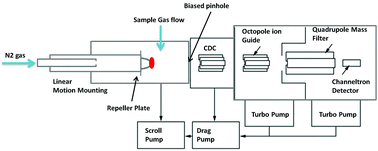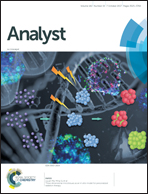Development of lithium attachment mass spectrometry – knudsen effusion and chemical ionisation mass spectrometry (KEMS, CIMS)†
Abstract
Lithium ion attachment mass spectrometry provides a non-specific, non-fragmenting, sensitive and robust method for the detection of volatile species in the gas phase. The design, manufacture and results of lithium based ion attachment ionisation sources for two different mass spectrometry systems are presented. In this study trace gas analysis is investigated using a modified Chemical Ionization Mass Spectrometer (CIMS) and vapour pressure measurements are made using a modified Knudsen Effusion Mass Spectrometer (KEMS). In the Li+ CIMS, where the Li+ ionization acts a soft and unselective ionization source, limits of detection of 0.2 ppt for formic acid, 15 ppt for nitric acid and 120 ppt for ammonia were achieved, allowing for ambient measurements of such species at atmospherically relevant concentrations. In the first application of Lithium ion attachment in ultra-high vacuum (UHV), vapor pressures of various atmospherically relevant species were measured with the adapted KEMS, giving measured values equivalent to previous results from electron impact KEMS. In the Li+ KEMS vapour pressures <10−3 mbar can be measured without any fragmentation, as is seen with the initial electron impact (EI) set up, allowing the vapor pressure of individual components within mixtures to be determined.



 Please wait while we load your content...
Please wait while we load your content...